Welsh Presbyterian Church was a bilingual Welsh/English congregation in the Pico-Union neighborhood of Los Angeles, California, founded in 1888 and dissolved in 2012.
Contents
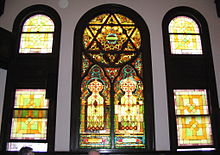
Welsh Presbyterian Church was a bilingual Welsh/English congregation in the Pico-Union neighborhood of Los Angeles, California, founded in 1888 and dissolved in 2012.

The Welsh Church in Los Angeles was founded in 1888 by Rev. David Hughes (1833–1903). Hughes, born in Wales, founded two separate congregations in the city, preaching English sermons to one, and Welsh sermons to the other, every Sunday. [1] Rev. E. L. Jones of Denver was installed as pastor in 1910, when the church was meeting at 438 Crocker Street, and holding weekly Sunday services in Welsh and English. [2] In 1926, the Welsh Church moved into a building at 1153 Valencia Street, once occupied by the conservative Jewish congregation still known as Sinai Temple. [3]
In the 1980s, despite limited resources, the congregation undertook seismic retrofitting of the church building, rather than allow it to be demolished as unsafe. [4]
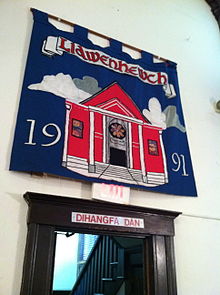
In 2012, the church's congregation had dwindled to about ten active members. It continued to hold Welsh-language worship services, concerts, and cultural events into its last years, [5] but had not had a full-time pastor since 1964. The Welsh Presbyterian Church was dissolved as a church in December 2012. The building was sold again, to Craig Taubman, and now is home to the multifaith Pico Union Project. [6]
Between 2014 and 2016 the church was used by the Welsh League of Southern California for their Gymanfa Ganu events.[ citation needed ]
The Welsh Church building was built in the Greek Revival style in 1909, and is the oldest remaining synagogue building in Los Angeles. [7] It has been recognized as a Historic-Cultural Monument by the Los Angeles Cultural Heritage Commission, and contains a historic pipe organ build by Murray M. Harris in 1909. [8]
Members of the Welsh Presbyterian Church in Los Angeles were recruited to appear and sing in the 1941 film adaptation of How Green Was My Valley. [9]

The New York Avenue Presbyterian Church was formed in 1859–1860 but traces its roots to 1803 as the F Street Associate Reformed Presbyterian Church and another congregation founded in 1820 on its current site, the Second Presbyterian Church.

Grace Community Church is a non-denominational, evangelical megachurch founded in 1956 and located in Sun Valley, a neighborhood in the San Fernando Valley of Los Angeles. Speaker and radio evangelist John MacArthur is the senior pastor of Grace Community Church. As of 2008, the average weekly attendance was 8,258.
Warrenton Presbyterian Church is a Presbyterian congregation in Warrenton, Virginia that was organized around 1780.

Coral Ridge Presbyterian Church is a Christian megachurch within the Presbyterian Church in America located in Fort Lauderdale, Florida. It was founded in 1960 by D. James Kennedy (1930–2007), who served as the church's senior pastor until shortly before his death.

St. Andrew's Scots Kirk, is located at 73 Galle Road, Colombo. The church was founded in the late 19th century, and prospered during the colonial and post-colonial periods. It was the centre for the Scottish community in Colombo.

The First Presbyterian Church of Hollywood is a Presbyterian Church (USA) congregation in the Hollywood neighborhood of Los Angeles, California that has had a significant impact on both the Presbyterian Church and evangelical Christianity around the world.

Fifth Avenue Presbyterian Church is a Presbyterian Church (U.S.A.) church in New York City. The church, on Fifth Avenue at 7 West 55th Street in Midtown Manhattan, has approximately 2,200 members and is one of the larger PCUSA congregations. The church, founded in 1808 as the Cedar Street Presbyterian Church, has been at this site since 1875.
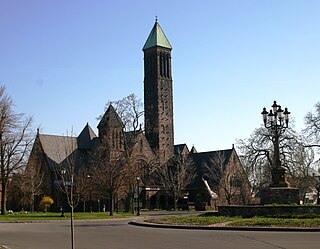
The First Presbyterian Church in Buffalo, New York was the first organized religious body formed in what was then the western frontier of New York State. The town of Buffalo was sparsely populated when the church was organized on February 2, 1812. However, having survived the War of 1812, the town of Buffalo was rebuilt and rapidly grew with the completion of the Erie Canal in 1825. The first two buildings were located on the same downtown lot. However, the congregation relocated between 1889 and 1891 to its present location approximately one and-a-half miles to the north in a more residential area.

Historic First Bryan Baptist Church is an African-American church that was organized in Savannah, Georgia, by Andrew Bryan in 1788. Considered to be the Mother Church of Black Baptists, the site was purchased in 1793 by Bryan, a former slave who had also purchased his freedom. The first structure was erected there in 1794. By 1800 the congregation was large enough to split: those at Bryan Street took the name of First African Baptist Church, and Second and Third African Baptist churches were also established. The current sanctuary of First Bryan Baptist Church was constructed in 1873.

The Old Presbyterian Meeting House is a Christian church located at 321 South Fairfax Street in the Old Town neighborhood of Alexandria, Virginia. It is part of the National Capital Presbytery and the Synod of the Mid-Atlantic of the Presbyterian Church (USA).

Shepherd Church is a nondenominational megachurch based in Porter Ranch, Los Angeles, California, USA. The senior pastor is Dudley Rutherford.
West Presbyterian Church was a congregation and two houses of worship in Manhattan, New York City. The congregation was founded in 1829 and merged in 1911 with Park Presbyterian Church to form West-Park Presbyterian Church. The first house of worship, also known as the Carmine Street Presbyterian Church, in Greenwich Village, was used from 1832 to 1865, and the second, on West 42nd Street between Fifth Avenue and Sixth Avenue, from 1865 until 1911, when it was sold and demolished. Proceeds from the sale were used, in accordance with the merger agreement, to build and endow a church for an underserved neighborhood, Washington Heights: Fort Washington Presbyterian Church. In addition, the West Church congregation had earlier established two mission churches which eventually merged to become Good Shepherd-Faith Presbyterian Church. West-Park, Fort Washington, and Good Shepherd-Faith are all active today.
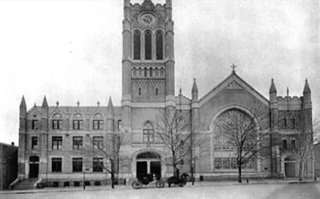
The congregation of North Presbyterian Church, at 525 West 155th Street in Manhattan, New York City, is a combination of three former congregations: North Presbyterian Church, Washington Heights Presbyterian Church, and St. Nicholas Avenue Presbyterian Church.

The Fourth Presbyterian Church of Chicago is one of the largest congregations of the Presbyterian Church (U.S.A.), located in the Magnificent Mile neighborhood of Chicago, directly across Michigan Avenue from the John Hancock Center.

The Church of the Pilgrims is a Presbyterian Church (USA) congregation located in Washington, D.C., in the United States. The congregation was founded in 1903 as the Second Southern Presbyterian Church and took its current name in 1919. The congregation resides in a Gothic Revival church located at 22nd Street NW and P Street NW. The building was designed by architect Benjamin C. Flournoy of Baltimore, Maryland, and completed in March 1929.
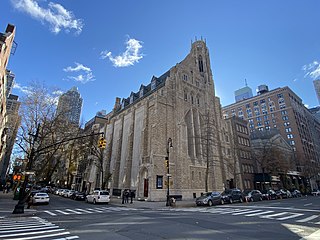
Central Presbyterian Church is a historic congregation on the Upper East Side of Manhattan in New York City, founded by pastor and abolitionist William Patton in 1821. It is a member of the Evangelical Presbyterian Church, and it worships in a Gothic Revival structure completed in 1922 that was originally commissioned and largely funded by John D. Rockefeller Jr. as Park Avenue Baptist Church.

Immanuel Presbyterian Church is a church in Los Angeles, California. The congregation was established in 1888 in downtown Los Angeles as a spinoff from the existing First Presbyterian Church, also then located in downtown. The church's current building was completed in 1929, and is located on Wilshire Boulevard in what is now the Koreatown district of Los Angeles. The church was listed as a Los Angeles Historic-Cultural Monument on February 4, 2003.

Jamaica First German Presbyterian Church is a historic Presbyterian church in the Jamaica neighborhood of Queens in New York City.

Westminster Presbyterian Church is in the Jefferson Park neighborhood of Los Angeles, California. Westminster Presbyterian Church is a member of the Presbyterian Church (U.S.A.), the Synod of Southern California and Hawaii and Pacific Presbytery. The congregation, established in 1904, is one of the oldest African American Presbyterian churches in California and west of the Mississippi River.